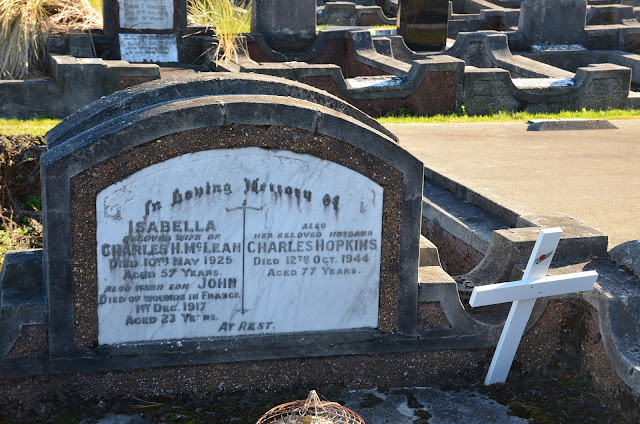It has been a little confusing finding the story of John McLean. The John McLean who died in 1917 has been slightly confused in online records with another man of the same name, buried in the same cemetery in which this John McLean is commemorated on a family gravestone. There is also the complication that, in searching online, newspapers would publish the name "McLean" as "M'Lean."
John McLean, sone of Charles Hopkins McLean died in a battle which was not the British Army's finest hour. This is assuming that, coming from Otago, he was enlisted in the Otago Infantry Regiment, and the newspaper reports seem to bear this out. The battle is described as follows in the Regiment's Official History: "By a set of circumstances, in the course of their development curiously alike those which marked the tragic failure of Passchendaele, the attack against Polderhoek Chateau was from the outset destined to fall short of its mark. The fixed starting line of the artillery barrage for the operation was 150 yards in advance of that on which the foremost infantry were assembled. By some fatal miscalculation or influence a considerable part of the entire weight of the barrage fell across the area occupied by the first waves of the assaulting troops. The immediate outcome was that the two leading Companies, 4th on the left and 10th on the right, became seriously involved in the destructive fire of our own artillery. The losses incurred were at once severe. To move forward was accepted as the quickest method of escaping our own fire, because more appeared to be falling to the rear than to the front. Captain Hines, commanding 4th Company, accordingly gave the order to advance, and 10th Company on the right almost immediately followed suit. But the irregularity of the barrage was such that some distance had to be covered before it was cleared, and by that time casualties, now increased by enemy machine gun fire, were so heavy as to seriously prejudice the success of the attack. It was during this stage of the advance that 2nd-Lieut. F. Marshall, of 4th Company, was killed, and that Captain Hines was wounded, though he continued to lead forward his Company. Approximately 150 yards beyond our old front line the second wave merged into the first. Captain Bryce, commanding 10th Company, was at this moment severely wounded, and while making his way back was killed. Command of 10th Company was taken over by Lieut. H. Digby-Smith.

No comments:
Post a Comment